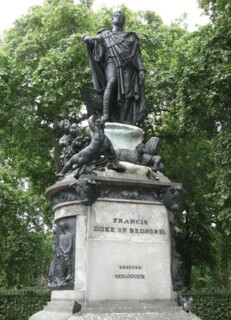Most days I eat my lunch sitting under the statue of Charles James Fox in Bloomsbury Square. There are broad steps on each side of the statue, their Portland stone now stained an aqueous green, and I like to sit beneath and between Fox’s feet, looking, with him, down Bedford Place and towards Russell Square. Like most fat men in statuary (and in life), Fox is seated for greater dignity; he is also swathed in a voluminous toga which drips over the edge of his chair – ‘Charles James Fox unconcerned in a bath towel sits on his arse in Bloomsbury Square,’ was how Louis MacNeice put it in one of his last poems. His right leg is extended so that one sandalled foot edges over the pediment – my fingers fit easily into the grooves between his toes. Most days, passers-by stop to look at the statue. You can get a good view of it from the pavement on Great Russell Street, but most people see it first from behind as they’re walking in Bloomsbury Square. It’s enclosed by a fence, and to get to the front you have to enter a gate and walk around. I watch as people approach, look past and above me, scrutinise the name in green-spotted brass, and shrug their shoulders. Quite often the whole process is wordless, as when someone in a TV police procedural is led up to a body in a morgue only to discover it’s not their friend/lover/mother after all – there’s a moment’s pause, a short mortified shake of the head, and a guilty step away. I’ve been sitting under the statue for more than two years now, but I can remember only two occasions when someone has known who Fox was. Several times, I’ve come close to looking up brightly from my sandwich and giving the biographical particulars, a sort of flashmob of one. But I haven’t yet.
It’s easy not to think about the statues whose existence we accept as the backdrop to our lives for no reason other than that they’re there. It’s only when you begin to look at them properly that they seem stranded, shipwrecked by history. ‘Age may not weary them,’ Geoff Dyer has written of the army of bronze soldiers on permanent guard at First World War memorials, ‘but … powerless to protect themselves, their only defence, like that of the blind, is our respect.’ Putting aside, for a moment, the vexed presences of Cecil Rhodes and Robert E. Lee, it is worth considering how many statues – the Public Monuments and Sculpture Association counts 925 in the UK – should continue to enjoy the protection of our respect. Should Charles James Fox? I have often wondered what I would say were I brave enough to pipe up one lunchtime in Bloomsbury Square. ‘Mr Fox excelled all his contemporaries in the extent of his knowledge, in the clearness and distinctness of his views, in quickness of apprehension, in plain, practical common sense,’ Hazlitt wrote. ‘The greatest genius that perhaps this country has ever produced,’ Burke said (when they were still friends). Catherine the Great commissioned a bust, and placed it between Demosthenes and Cicero.
Fox was a great Whig; a great orator; a great statesman. But words and phrases can become stranded too, and none of these mean what they used to. Fox was in opposition most of his life and it would be hard to make a list of his achievements. But he was a passionate opponent of the slave trade, and almost the last thing he did in Parliament was to propose the bill to abolish it on 10 June 1806: ‘So fully am I impressed with the vast importance and necessity of attaining what will be the object of my motion this night, that if, during the almost forty years that I have had the honour of a seat in Parliament, I had been so fortunate as to accomplish that, and that only, I should think I had done enough.’
There is some appeal in the idea of a commission appointed to investigate the state of statuary in this country, to sift through the persons previous ages deemed worthy of public space, asking whether they have been forgotten, and if not, what they are remembered for. Does their prominence perpetuate values with which we no longer wish to be associated? Do other values outweigh or counterbalance these? Such questions evoke strong feelings. Our protectiveness about some statues and our intolerance of others both derive from the sense that they represent something settled and permanent. But this is another insidious effect of time. Statues don’t stay still, for a start. The bronze equestrian statue of Charles I at Charing Cross, now trapped behind a moat of traffic, was cast in 1633 but only installed in its current position in 1675. Originally it stood in the Roehampton garden of Charles’s treasurer, Richard Weston. During the Civil War it was buried beneath a sympathetic metalsmith’s flowerbeds. Blind to the decapitation of its flesh-and-blood original in 1649, it was brought back into the light only after the Restoration. By the time it was set up at Charing Cross, Cromwell’s head had been rotting on a spike above Westminster Hall for 15 years: the connection between the two heads almost in sight of each other wouldn’t have been lost on anyone. (Further proof that you can’t keep a good statue down is provided by the bronze of Charles’s ill-fated son, James II, deposed in the Glorious Revolution of 1688, which stands nearby, outside the National Gallery.)
Public memorials don’t always stay the same either. The base of the Monument to the Great Fire of London, unveiled in 1677, was originally inscribed with a straightforward record of houses lost and streets burned; in 1681, at the height of a wave of anti-Catholic hysteria, another inscription was added blaming the fire ‘on the treachery and malice of the Papists’. This addendum was removed in 1685 after the accession of James, a Catholic, but quickly reinscribed in 1689 after he had been driven out the country (‘Where London’s column pointing at the skies/Like a tall bully, lifts the head, and lies,’ Pope wrote fifty years later). The offending passage was removed, for the final time, after Catholic Emancipation in 1830.
In their well-worn serenity, statues have the appearance of denying controversy, placidly asserting their innocence. For those who know who Charles James Fox was – and even for those who don’t – his statue in Bloomsbury Square seems to attest only to his significance as a national figure. It wasn’t, however, set up by a grateful nation, but by his friends and supporters in the Whig Party. Unveiled on 19 June 1816, nearly ten years after his death, it was part of a concerted effort to build a political identity around his cherished memory (Fox clubs and dinners were simultaneously springing up all over the country). Bloomsbury was Whig country, the land owned by the Dukes of Bedford, and the statue was the work of Richard Westmacott, artist-in-residence at Holland House, the Whigs’ political base.
At the other end of Bedford Place, directly opposite Fox in front of Russell Square, is a statue of Francis Russell, fifth duke of Bedford, erected in 1809 and also by Westmacott. He was a devoted Foxite. Approached from Bloomsbury Square, Bedford, standing, appears as the upright consequence of Fox’s tutelage; approached from Russell Square, Fox, the seated sage, swells in your field of vision as the source of all wisdom and inspiration. A line of influence running the length of the street, it is a marvellous piece of political theatre, and to become aware of it is to be reminded that there are bits of the city that don’t actually belong to us.
It is this sort of feeling, more than any other, which makes us reluctant to interfere. Whatever the tumult of history, the argument goes, we live in safer, stiller times, and to remove a statue is to inflict an injury on the integrity of the past. One of the clearest obstacles to any potential weeding out is the fact that many statues are protected by law: Fox’s, for example, is Grade II listed (‘an early appearance of this type of bronze memorial’; ‘of particular historical interest, having been erected to commemorate [Fox] … who played an important role in securing the passage of the 1807 Act abolishing the slave trade’; ‘the connection between the statue of Fox and that of Francis Russell, Duke of Bedford … adds to its historical and topographical importance, as a well-preserved piece of neoclassical urban planning with a strong political message’). It is hard to imagine this form of cultural logic ever being overturned, and in the majority of cases I’m not sure I would want it to be. It relies, however, on the paradox that statues become most effective (and valuable) as public memorials as the conditions of their creation recede from collective memory, even as the passage of time undermines the effects intended by those who commissioned and paid for them. We can view Fox’s statue with a detachment that would have been impossible for most people living in the 19th century. But when the original context refuses to go away – which is the case with statues of Rhodes and Lee – we are entitled to see them clearly and coldly, as intrinsically political objects.
The people who put our statues up weren’t thinking about the long term. Whatever their talk of eternal glory and perpetual fame, they were no more capable of imagining three or five hundred years into the future than we are. Statues are always the legacies of particular presents, in all their complexity and contingency, and they shouldn’t be allowed to create the impression of a unitary culture, or a hierarchy of historical importance, not least because so few are of individual women (158 out of the 925 in the UK, most of them of allegorical figures and 29 of Queen Victoria, according to the campaigner Caroline Criado-Perez). Plans to immortalise – the language is inescapable – great women of the past by casting new statues are worth supporting. We should be wary, though, of putting too many weights on the future, in a futile attempt to prevent it getting away from us. We are far more likely to confuse our descendants, in the way that we have been confused. Rumour has it that the fourth plinth in Trafalgar Square – vacant for 176 years, and since 2003 home to a series of contemporary sculptures – is destined to be filled by a statue of the queen after her death. That would be a shame. Far healthier to keep it empty, and to put up many more empty plinths while we’re at it, all of them forever waiting for someone to happen. And meanwhile Charles James Fox, unconcerned in his bath towel, can sit on his arse in Bloomsbury Square.
Send Letters To:
The Editor
London Review of Books,
28 Little Russell Street
London, WC1A 2HN
letters@lrb.co.uk
Please include name, address, and a telephone number.



